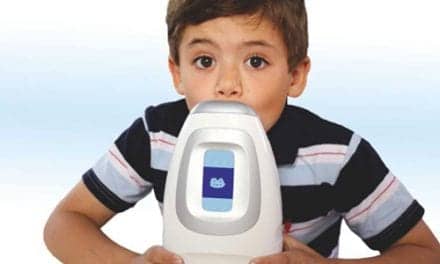Severe asthma patients account for as much as 60% of all asthma healthcare costs. Given this economic impact, proper management of severe disease is essential for healthcare providers.
By Bill Pruitt, MBA, RRT, CPFT, FAARC
Currently, 25 million Americans have asthma, and an estimated 5-10% suffer from severe disease. These severe asthma patients account for as much as 60% of all asthma healthcare costs. Given the economic impact of asthma-related hospitalizations and emergency room visits, proper management of severe disease is essential for healthcare providers.
This article will explore bests practices for management of severe asthma, with an emphasis on GINA 2023 clinical guidelines, and how effective pulmonary function testing, pharmacology, patient education, and telehealth can support patient health.

Asthma Overview
According to the 2023 Global Initiative for Asthma (GINA) Report, asthma is a disease of the airways and is characterized by airway inflammation, hyperresponsiveness or “twitchy airways,” and excess mucus production.1 The symptoms of an asthma attack include wheezing, chest tightness, cough, shortness of breath, and decreased expiratory airflow. Symptoms vary in intensity and in duration and can resolve spontaneously or may call for medication. The timing of asthma symptoms can range from very infrequent (spanning weeks or months) to continuous, and even with mild cases a flare up of asthma can be life-threatening.1 Asthma is defined by different clinical characteristics or phenotypes including allergic and non-allergic asthma, adult-onset asthma, asthma with persistent airflow limitation, and asthma with obesity.1 Asthma may be linked to the work environment (occupational asthma) or may be linked to exercise (exercise-induced bronchospasm or EIB).2
Diagnosis
A clear diagnosis of asthma is sometimes difficult to establish and requires a careful evaluation to rule-out other conditions. Often a patient is misdiagnosed as having asthma or may be misdiagnosed with some other condition when in fact it is asthma and not another issue. The presence of symptoms is the first clue—when are the symptoms appearing (under what circumstances?) What caused the symptoms (if anything can be identified)? How long do the symptoms last? What (if anything) brings relief? Next, does the patient’s history and examination support a diagnosis of asthma? Are there any other possible causes for the symptoms, (ie, smoking-related disease, abnormal vocal cord function, infection, foreign-body aspiration, bronchiectasis, cystic fibrosis)?
Spirometry is a key measurement in the evaluation—patients with asthma often have a reduced FEV1 and FEV1/FVC reflecting expiratory airflow obstruction that can be reversed by a short-acting bronchodilator (SABA). The GINA 2023 guidelines use the conventional definition of a significant response to a SABA—namely a >12% and >200 mL increase in the FEV1 and FVC respectively. For patients already receiving treatment, medications should be withheld prior to performing spirometry to obtain a baseline measurement. This entails a 4-hour hold from taking a SABA, 24-hour hold from twice daily inhaled corticosteroid/long-acting beta agonist (ICS-LABA), or a 36-hour hold from daily ICS-LABA. Testing should be performed by well-trained operators using PFT devices that have be well-maintained and calibrated regularly, with an in-line filter to protect the patient(s) and operator from possible exposure to infectious aerosols.
However, some patients may have normal spirometry results, so other pulmonary function tests (PFTs) may be needed, such as a bronchial challenge (or bronchial provocation) test. A positive bronchial challenge test is defined as a drop in FEV1 from the baseline by >20% using standard doses of methacholine, or a >15% drop in FEV1 using other challenge tests (hyperventilation, inhaled hypertonic saline, or inhaled mannitol). Allergy skin testing also helps uncover allergic asthma phenotypes. Imaging is routinely utilized in the initial evaluation but helps in finding possible comorbid conditions or distinguishing an alternative diagnosis. Computerized tomography (CT) of the sinuses may find chronic rhinosinusitis with or without nasal polyps which can aid in the management of some asthma patients if present.1
Severe Asthma
Asthma is generally classified as being mild, moderate, or severe. Severe asthma is described as having uncontrolled symptoms despite being on a two to three month treatment of high-dose inhaled corticosteroid (ICS) combined with a long-acting beta agonist (LABA) or in a case that requires taking high-dose ICS/LABA medication to keep it from becoming uncontrolled.1 (See Table 1 for a description of the current ICS/LABA medications.)
Note that GINA 2023 advises distinguishing severe asthma from difficult-to-treat asthma which may be the case when the situation involves inadequate or inappropriate treatment, when faced patients who do not adhere to the treatment plan, or when there are comorbid conditions such as chronic rhinosinusitis or obesity.
Figure 1. Current ICS/LABA medications
| Generic names | Trade names |
| Formoterol/budesonide | Symbicort |
| Formoterol/beclomethasone | Fostair, Modulite |
| Formoterol/mometasone | Dulera |
| Salmeterol/flucticasone propionate | Advair Diskus |
| Vilanterol/flucticasone furoate | Breo Ellipta |
Management of Severe Asthma
Severe asthma needs to be managed by a specialist who is well-versed in investigation and management of this disease. The GINA 2023 guidelines for severe asthma recommend using a high-dose ICS/LABA medication and if symptoms are still present, begin adding long-acting muscarinic antagonists (LAMA), leukotriene receptor antagonists (LTRA), leukotriene modifiers (LM), low-dose azithromycin in adults, and/or biologic agents as appropriate. If triple therapy is needed, LABA-LAMA-ICS medications in a single inhaler are often the best choice to simplify the treatment plan. (See Table 2 for triple therapy medications.)
Table 2. Triple Therapy Medications (combinations of LABA-LAMA-ICS in a single device)
| Generic names | Trade names |
| Beclomethasone dipropionate/formoterol/glycopyrronium | Trimbow |
| Fluticasone furoate/vilanterol/umeclidinium | Trelegy Ellipta |
| Budesonide/glycopyrronium/formoterol | Breztri Aerosphere |
Biologic agents are the newest medications being used in treating asthma. These drugs are indicated in Type 2 asthma patients who have high eosinophil counts or elevated FeNO. Biologics act to block inflammatory pathways that are mediated by IgE and IL-4, IL-5, IL-13 and thymic stromal lymphopoietin (TSLP). (See Table 3 for biologics.)
Low-dose oral corticosteroids (OCS) are reserved to be a last resort if there is no significant improvement in symptoms. OCS are associated with serious long-term side effects which have to be considered in choosing this final step. Ineffective treatments should be stopped. Some patients with severe asthma may also benefit from bronchial thermoplasty to reduce the number of airway smooth muscles and limit the airway’s capacity to shift into full-blown bronchospasm. The GINA 2023 guidelines provide recommendations for when and how to step-up and step-down in therapy.
Table 3. Biologics
| Generic names | Trade names | Active site |
| Benralizumab | Fasenra | IL-5 |
| Dupilumab | Dupixent | IL-4, IL-13 |
| Mepolizumab | Nucala | IL-5 |
| Omalizumab | Xolair | IgE |
| Reslizumab | Cinqair | IL-5 |
| Tezepelumab | Tezspire | Anti-TSLP |
When a patient continues to have symptoms or exacerbations despite treatment, several areas need to be investigated. First, the patient should be observed while self-administering their inhaled medications to ensure that all the proper steps are being followed (poor self-administration using inhalers is frequently uncovered when the patient’s technique is observed by a trained professional). There needs to be a discussion related to barriers such as high medication costs and beliefs about medications (many are reluctant to take any medications, believe the medication is causing harm, or believe that once they feel better they can stop the treatment).
Second, the diagnosis of asthma needs to be confirmed by repeating spirometry or by performing a bronchial challenge test. Third, remove possible risk factors if possible (for example, smoking, use of beta-blockers or non-steroidal anti-inflammatory medications like aspirin or ibuprofen, occupational or home exposure to triggers/allergens). In addition, treat any comorbid conditions that could affect symptoms—including obesity, rhinitis, gastroesophageal reflux (GERD), obstructive sleep apnea (OSA). Once these have been addressed, the patient may need to move up to the next step in intensity of treatment, and/or the patient may need to go to a specialist trained in asthma, allergy, and immunology.
Note that regular or over-use of short-acting beta agonists (SABAs) can lead to reduced response to the medication due to down-regulation of the beta receptors. If the pharmacy has dispensed three or more SABA inhalers in a year the patient has a greater risk of going to the emergency department or being hospitalized regardless of the asthma severity, and if twelve or more SABA inhalers have been dispensed risk of death is greatly increased.1
Exacerbation of Severe Asthma
When asthma symptoms flare-up, the patient may need to have changes made in the management or may need to be hospitalized. All patients with asthma should have a written asthma action plan (AAP) that describes their baseline status, the medications they are taking including the name, classification of drug (ie, SABA, ICS, LABA, etc) medication dose, and frequency of self-administration, what to do for self-management if symptoms increase, when it is time for a visit to their primary care provider or emergency room, and when/how to call for an emergency response (ie, call 911).
Often the patient can gain control of symptoms at home if following a well-written AAP that provides for a temporary step-up in therapy. Patients with severe asthma who are unable to gain control of their symptoms in a short period of time need to be seen immediately in a doctor’s office, urgent care, or in the emergency department, and may need to be hospitalized.
Patient Education
Education (for both the patient and family) is essential for anyone with asthma. Effective self-management requires that the patient knows about the disease and their triggers, symptoms, details on medications (including what the medication is, what it does, the dose and frequency, storage, priming, and correct technique in using inhalers—and possible spacer or valved-holding chambers). Patient education about their asthma needs to be done with every visit. Educational materials should be written in the appropriate language and at a 5th or 6th grade level to enhance understanding.3 The patient, family, and coaches, teachers, etc (for school-aged patients) should have a copy of a personalized written asthma action plan that is up-to-date. Patients need to be involved in shared-decision making to create a workable plan that they are most likely to follow.
Telehealth in Severe Asthma
Telehealth (also called telemedicine) can be provided as an adjunct to office visits to support patients with severe asthma. Telehealth may be a face-to-face live visit with a patient and allow for assessing triggers in the home, discussion of symptoms, review of inhaler technique, etc. Remote monitoring may also be performed using items such as a digital scale, thermometer, blood pressure device, digital stethoscope, pulse oximeter, peak flow meter, and home-based spirometer. Patients can also use telehealth to access educational/training materials on their own schedule. Some inhalers are being produced that will provide details on inhaler usage and even monitor inspiratory flow to gauge the effectiveness of the inspiration.
Telehealth can also help provide access to specialists that would otherwise be blocked by time, cost, or distance. As a review article published in 2022 states, “Using telemedicine to connect specialists with various points of care in a community for chronic medical conditions such as asthma will be the future of healthcare. Furthermore, personalized medicine conducted in the home environment will be where most medical education and care will be done in the future, instead of the traditional office setting”.4
Conclusion
Severe asthma is a challenging disease to manage and needs to involve asthma specialists to work with the patient/family to find the best plan of care. Spirometry is an essential part of diagnosis and follow-up to monitor and adjust treatment. Patient education and shared-decision making plays an important part in tackling this difficult disease, and a up-to-date written action plan should be prepared and shared with the patient, family, and others who need to know about the plan of care (teachers, coaches, school nurses, etc. Medications used to treat severe asthma are changing and there is a need for providers and other members of the healthcare team to stay current with the new medications and delivery devices, as well as staying up-to-date with the changing evidence-based guidelines. Telehealth can provide timely, personal virtual visits, monitoring, education, and other resources, and may provide access to specialists that otherwise would not be feasible.
Effective management of severe asthma calls for a team approach that keeps the patient in the center and utilizes the best strategies to keep symptoms under control.
RT
Bill Pruitt, MBA, RRT, CPFT, FAARC, is a writer, lecturer, and consultant. He has over 40 years of experience in respiratory care and has over 20 years teaching at the University of South Alabama in Cardiorespiratory Care. Now retired from teaching, he continues to provide guest lectures and write professionally. For more info, contact [email protected].
References
- 2023 Global Initiative for Asthma (GINA) Report: Global Strategy for Asthma Management and Prevention. Available here.
- From the Cleveland clinic website, Asthma. Available here.
- From the AHRQ Health Literacy Universal Precautions Toolkit, Second Edition. Available here.
- Persaud YK. Using telemedicine to care for the asthma patient. Current Allergy and Asthma Reports. 2022 Apr;22(4):43-52.










